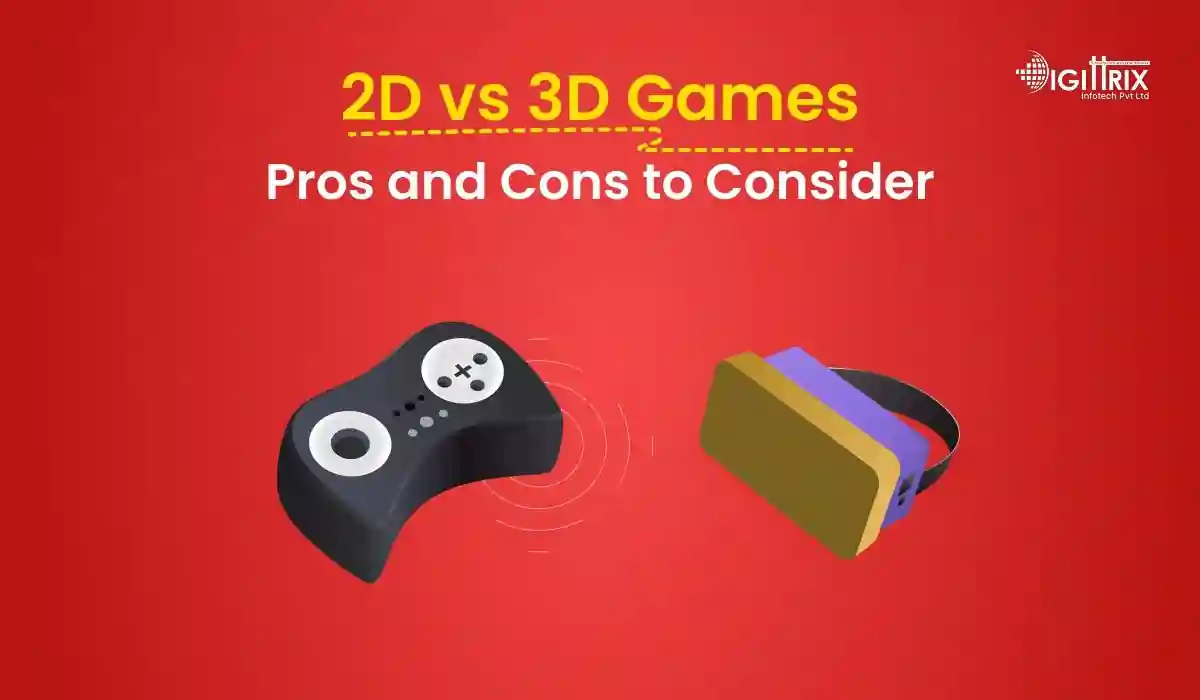Gamers are drawn to 3D environments for open-world adventures, while 2D platformers continue to hold strong appeal. Minimalist 2D designs often result in higher player retention.
Highlights
An enthusiastic developer and skilled business management expert with over a decade of experience in the field

Game development has evolved significantly over the years, with both 2D and 3D games offering unique experiences for players. If you are planning to build a game, choosing between 2D and 3D can be challenging. Both options come with advantages and limitations, depending on factors like budget, target audience, and complexity. Whether you are working with a 3d game app development company or hiring 3d game app developers, understanding the key differences can help in making the right choice.
Planning a HeadsUp-style game? Check Digittrix's guide for development insights and cost breakdown!
2D games use two-dimensional graphics, meaning they have height and width but no depth. These games are usually designed with flat visuals and are viewed from a side, top-down, or isometric perspective. Examples of popular 2D games include classic arcade games like Super Mario Bros., Pac-Man, and Terraria.
MoldStud report says, 2D platformers attract 55% of players while 45% favour 3D versions.
3D games use three-dimensional graphics, adding depth to objects and environments. These games create a more realistic visual experience and allow for more complex character movements and camera angles. Well-known 3D games include Grand Theft Auto V, Call of Duty, and Minecraft.
According to the MoldStud report, around 70% of gamers prefer 3D environments for open-world adventures.
Creating 2D games is usually less expensive than creating 3D games. The art style requires fewer resources, and the overall development process is simpler. This makes 2D games a great choice for startups and independent developers with limited budgets.
Since 2D games require less complex programming and animation, they can be built more quickly. Mobile game development in 2D is often preferred when developers want to release games within a short timeframe.
2D games are usually simple and easy to understand. Many mobile games, including puzzle and platformer games, use 2D graphics because they require less effort for players to navigate.
2D games do not demand high-end hardware, making them suitable for older smartphones and computers. This ensures a wider reach, especially in markets where high-performance devices are less common.
According to MoldStud, games with minimalist 2D designs usually achieve higher user engagement.
Since 2D games lack depth and realistic graphics, they may not be as visually engaging as 3D games. This can be a drawback when targeting audiences who prefer immersive environments.
With limited movement options, 2D games may not offer as much variety as 3D games. Many advanced mechanics, such as free camera movement and realistic physics, are difficult to implement in 2D.
While 2D games remain popular, many players today prefer 3D experiences, especially for action, racing, and adventure games. The demand for 2D games is generally lower than for 3D games in some gaming markets.
3D games offer a visually engaging experience by simulating real-world environments. They provide depth, lighting effects, and smooth animations, making them ideal for open-world and action-adventure games.
Players can move in multiple directions, interact with objects from different angles, and explore detailed environments. This makes 3D games suitable for genres like first-person shooters, racing games, and RPGs.
Most modern console and PC games are 3D because players seek high-quality experiences. A well-designed 3D game can attract a larger audience and generate significant revenue.
With 3D graphics, game developers can integrate realistic physics, character movements, and interactive elements. This allows for dynamic gameplay, which is crucial for multiplayer and competitive games.
3D games require advanced design skills, complex coding, and more powerful hardware for rendering. This leads to higher expenses, making it a challenge for small studios or independent developers.
Due to the complexity of 3D models, animations, and mechanics, development can take months or even years. Games like Cyberpunk 2077 and The Witcher 3 required long production times and large teams to complete.
3D games need high-performance hardware to run smoothly. This limits accessibility for users with older devices, especially in mobile gaming. Android game development must consider optimization to ensure compatibility with a wide range of devices.
Creating 3D assets, animations, and environments involves a steep learning curve. Additionally, debugging and fixing errors in 3D games can be more complicated than in 2D games.
Whether you choose 2D or 3D, working with experienced developers is crucial. A game app development company can help plan and execute your project efficiently. If you are focusing on mobile game development, hiring skilled game app developers with experience in 2D or 3D gaming is essential.
On-demand app development services can provide ready-made solutions for businesses looking to enter the gaming industry quickly. Many companies offer game development services tailored to specific needs, reducing the time and effort required to launch a game.
Regardless of the format, testing is an important step before launching a game. This includes fixing bugs, optimizing performance, and ensuring smooth gameplay across different platforms. Mobile app development teams often use multiple testing tools to check how well the game performs on Android and iOS devices.
Choosing between 2D and 3D games depends on various factors, including budget, target audience, and game complexity. While 2D games are cost-effective, easy to develop, and widely accessible, 3D games provide a richer, more immersive experience but require more resources. Before making a final decision, it is essential to evaluate the scope of your game and the expectations of your players. Whether you are an independent developer or working with a game app development company, understanding these differences will help you make the best choice for your project.
The demand for game app development is growing, as players engage in both 2D and 3D immersive gaming experiences. Businesses looking to invest in game development in 2025 can capitalize on this by offering engaging features, cross-platform functionality, and innovative monetization strategies.
When deciding between 2D and 3D games, it’s essential to understand the advantages of each format. Whether you opt for a classic 2D platformer or a rich 3D open-world game, selecting an experienced mobile game development company is crucial. At Digittrix, we specialize in custom game app development, delivering high-quality graphics, smooth gameplay, and secure payment integration. Whether you're developing a 2D side-scrolling adventure or an intricate 3D game, our expert game app developers create scalable, feature-rich solutions that align with your business goals.
Looking to learn more about 2D vs. 3D game development or the cost of building a game app? Contact our team today at +91 8727000867 or email digittrix@gmail.com for expert guidance.

Do you need help in Mobile App development?




Join over 1500+ businesses we've already helped!
2D games have flat graphics with height and width, while 3D games include depth, creating a more realistic and immersive experience.
2D games are generally less expensive to develop due to simpler graphics and fewer resource requirements.
Consider your budget, target audience, game complexity, and the devices you want to target before making a decision.
3D games tend to engage players more with immersive environments, but 2D games can be more accessible and easier to develop.

©2025Digittrix Infotech Private Limited , All rights reserved.